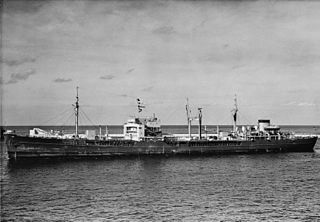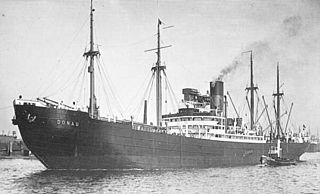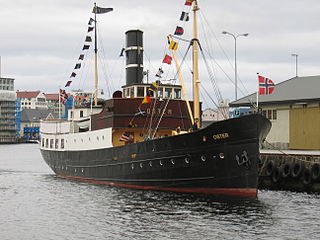
The Kriegsmarine was the navy of Germany from 1935 to 1945. It superseded the Imperial German Navy of the German Empire (1871–1918) and the inter-war Reichsmarine (1919–1935) of the Weimar Republic. The Kriegsmarine was one of three official branches, along with the Heer and the Luftwaffe, of the Wehrmacht, the German armed forces from 1935 to 1945.
Lothair is a Germanic given name, derived from the older form Clotaire (Chlotharius).

Kirkenes is a town in Sør-Varanger Municipality in Troms og Finnmark county, in the far northeastern part of Norway. The town lies on a peninsula along the Bøkfjorden, an arm of the large Varangerfjorden. The main church for Kirkenes is Kirkenes Church, located in the Haganes area of the town. Kirkenes is located just a few kilometres from the Norway-Russia border.

Nordmark was a former Kriegsmarine combination oiler and supply vessel which was allocated to the Royal Navy by the Inter-Allied Repatriations Commission when British forces entered Copenhagen on 9 May 1945.
Mountain Corps Norway was a German army unit during World War II. It saw action in Norway and Finland.

Admiral Hipper was the lead ship of the Admiral Hipper class of heavy cruisers which served with Nazi Germany's Kriegsmarine during World War II. The ship was laid down at the Blohm & Voss shipyard in Hamburg in July 1935 and launched February 1937; Admiral Hipper entered service shortly before the outbreak of war, in April 1939. The ship was named after Admiral Franz von Hipper, commander of the German battlecruiser squadron during the Battle of Jutland in 1916 and later commander-in-chief of the German High Seas Fleet. She was armed with a main battery of eight 20.3 cm (8.0 in) guns and, although nominally under the 10,000-long-ton (10,000 t) limit set by the Anglo-German Naval Agreement, actually displaced over 16,000 long tons (16,000 t).

Widder was an auxiliary cruiser (Hilfskreuzer) of Nazi Germany's Kriegsmarine that was used as a merchant raider in the Second World War. Her Kriegsmarine designation was Schiff 21, to the Royal Navy she was Raider D. The name Widder (Ram) represents the constellation Aries in German.

SS Donau was a Norddeutscher Lloyd refrigerated cargo ship. In the Second World War the Kriegsmarine used it as a transport ship between Germany and Norway. She became known as the "slave ship" after the SS and Gestapo transported 540 Jews from Norway to Stettin, from where they were taken by train to Auschwitz. Only nine of those deported on the Donau survived.

The Gauliga Nordmark was the highest football league in the Prussian Province of Schleswig-Holstein and the German states of Hamburg, Lübeck, Mecklenburg-Schwerin, Mecklenburg-Strelitz and parts of Oldenburg from 1933 to 1945. Shortly after the formation of the league, the Nazis reorganised the administrative regions in Germany, and the GaueHamburg, Mecklenburg and Schleswig-Holstein replaced the Prussian province and the German states in this northern region of Germany.

SS Oster is a Norwegian steamship built in 1908 by Christianssands Mekaniske Værksted for the Indre Nordhordlandske Dampskibsselskab to provide a combined passenger and cargo service between Bergen and Osterfjorden in Norway. During World War II she served as a guard ship with both the Royal Norwegian Navy and later with the German Kriegsmarine. Following the war she returned to civilian service and is still in service providing pleasure cruises from Bergen. In 1963 the Bergen deaf priest Ragnvald Hammer wrote the poem " Dar kjem dampen" in honor of the ship. Norwegian folksinger Ivar Medaas later added a tune to this poem.
The Point Andalusia was a set, secret, location in the Southern Atlantic Ocean, used by warships of Nazi Germany's Kriegsmarine during the Second World War.
German submarine U-57 was a Type IIC U-boat of Nazi Germany's Kriegsmarine that served in the Second World War. She was built by Deutsche Werke in Kiel as yard number 256. Ordered on 17 June 1937, she was laid down on 14 September, launched on 3 September 1938 and commissioned on 29 December under the command of Oberleutnant zur See Claus Korth.

Operation Weserübung was Germany's assault on Denmark and Norway during the Second World War and the opening operation of the Norwegian Campaign.
German U-boat bases in occupied Norway operated between 1940 and 1945, when the Kriegsmarine, converted several naval bases in Norway into submarine bases. Norwegian coastal cities became available to the Kriegsmarine after the invasion of Denmark and Norway in April 1940. Following the conclusion of the Norwegian Campaign, the occupying Germans began to transfer U-boats stationed in Germany to many Norwegian port cities such as Bergen, Narvik, Trondheim, Hammerfest and Kirkenes. Initial planning for many U-boat bunkers began in late 1940. Starting in 1941, the Todt Organisation began the construction of bunkers in Bergen and Trondheim. These bunkers were completed by Weyss & Freytagg AG between 1942 and 1943.

The action of 28 January 1945 was an inconclusive naval battle of the Second World War fought between two British Royal Navy light cruisers and three Kriegsmarine destroyers near Bergen, Norway. The battle was the last of many actions between British and German warships off Norway during the war and the second-to-last surface engagement to be fought by the Kriegsmarine. It resulted in heavy damage to one of the German destroyers and light damage to another destroyer and both British cruisers.

Z21 Wilhelm Heidkamp was one of six Type 1936 destroyers built for the Kriegsmarine in the late 1930s. Completed a few months before the start of World War II in September 1939, the ship served as a flagship throughout her career. She briefly patrolled the Skagerrak where she inspected neutral shipping for contraband goods. Z21 Wilhelm Heidkamp later helped to lay four offensive minefields off the English coast that claimed two British destroyers, 2 fishing trawlers, and twenty-seven merchant ships. During the German invasion of Norway in April 1940, she sank a Norwegian coastal defense ship off Narvik and was crippled with the opening shots of the First Naval Battle of Narvik on 10 April, with the loss of 81 crewmen. The ship sank the following day.
German submarine U-61 was a Type IIC U-boat of Nazi Germany's Kriegsmarine that served in the Second World War. It was built by Deutsche Werke AG, Kiel. Ordered on 21 June 1937, it was laid down on 1 October as yard number 260. It was launched on 15 June 1939 and commissioned on 12 August under the command of Oberleutnant zur See Jürgen Oesten.
Astrid Døvle Dollis Dahlgren was a Norwegian dentist and property dealer. After she became Swedish by marriage she worked for Nazi Germany during World War II.
Naval regions and districts were the official shore establishment of Nazi Germany's Kriegsmarine during World War II. The Kriegsmarine shore establishment was divided into four senior regional commands, who were in turn subordinated to the operational Navy Group commanders who commanded all sea and shore naval forces within a particular geographical region. Within each naval region were several subordinate naval districts who were responsible for all navy shore activities within their area of responsibility, most significantly were the various German ports of occupied Europe.

Luchs was the fourth of six Type 24 torpedo boats built for the German Navy during the 1920s. The boat made multiple non-intervention patrols during the Spanish Civil War in the late 1930s. During World War II, she played a minor role in the Battle of Kristiansand during the Norwegian Campaign of 1940. Luchs was sunk in Norwegian waters in July by either a British submarine or a floating mine.











